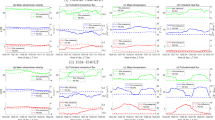Abstract
Nine tower datasets over grassland, brush rangeland, snow covered plain, the ocean, three different pine forests, an aspen forest and an urban site, are used to document the scale-dependence of the cross-wind velocity variance in the stable boundary layer. The turbulence velocity variance scales with the surface momentum flux, as reported in previous studies. Such scaling removes the stability dependence of the variance at a given site, and also removes most of the differences between sites. The scaling is more effective with use of a record-dependent averaging time for defining the turbulent fluctuations. The variable averaging time is the timescale associated with the gap region in the heat flux multiresolution cospectra.
On scales larger than turbulence and less than a few hours (mesoscale), variations in the cross-wind velocity variance at a given site are not related to local variables such as the friction velocity. Possible exceptions include suppression of turbulence and mesoscale motions in well-defined drainage flows and enhancement of turbulence and mesoscale motions in stronger winds downstream of a ridge. Larger mesoscale variance is associated with complex terrain and forested sites compared to the more homogeneous sites in flat terrain with short or no vegetation. These differences between sites are related to the absence of a gap region in the velocity spectra at the complex terrain and forested sites. The observed probability distribution functions of the total variance and the mesoscale variance are documented for different averaging times, stability classes and site characteristics.
Similar content being viewed by others
References
Acevedo OC, Moraes OLL, Degrazia GA, Medeiros LE (2006) Intermittency and the exchange of scalars in the nocturnal surface layer. Boundary-Layer Metro 119:41–55
Anfossi D, Oettl D, Degrazia G, Goulart A (2005) Anemometer observations in low wind speed conditions. Boundary-Layer Metro 114:179–203
Blanken PD et al. (1998) Turbulent flux measurements above and below the overstory of a boreal aspen forest. Boundary-Layer Metro 89:109–140
Caughey SJ (1977) Boundary-layer turbulence spectra in stable conditions. Boundary-Layer Metro 11:3–14
Chimonas G (1999) Steps, waves and turbulence in the stably stratified planetary boundary layer. Boundary-Layer Metro 90:397–421
Cimorelli AJ et al. (2005) AERMOD: a dispersion model for industrial source applications Part I: general model formulation and boundary layer characterization. J Appl Metro 44:682–693
Eckman RM (1994) Influence of the sampling time on the kinematics of turbulent diffusion from a continuous source. J Fluid Mech 270:349–375
Hanna SR (1983) Lateral turbulence intensity and plume meandering during stable conditions. J Appl Metro 20:242–249
Hanna SR (1986) Spectra of concentration fluctuations: the two time scales of a meandering plume. Atmos Environ 20:1131–1137
Howell JF, Mahrt L (1997) Multiresolution flux decomposition. Boundary-Layer Metro 83:117–137
Izumi Y (1971) Kansas 1968 Field Program data report. Air Force Cambridge Research Laboratory, No. 379, AFCRL-72-0041, p79
Lenschow DH, Sheng Li X, Jaun Zhu C, Stankov BB (1988) The stably stratified boundary layer over the Great Plains. Boundary-Layer Metro 42:95–121
Mahrt L, Gamage N (1987) Observations of turbulence in stratified flow. J. Atomas. Sci 44:1106–1121
Mahrt L, Sun J, Blumen W, Delaney A, .McClean G, Oncley S (1998) Nocturnal boundary-layer regimes. Boundary-Layer Metro 88:255–278
Mahrt L, Moore E, Vickers D, Jensen NO (2001) Dependence of turbulent and mesoscale velocity variances on scale and stability. J Appl Metro 40:628–641
Mallat SG (1989) The theory of multiresolution signal decomposition: the wavelet representation. IEEE Trans Pattern Anal Machine Intell 7:674–693
Maryon RH (1998) Determining cross-wind variance for low frequency wind meander. Atmos Environ 32:115–121
Moore GE, Milich LB, Liu MK (1988) Plume behaviors observed using lidar and SF6 tracer at a flat and hilly site. Atmos Environ 22:1673–1688
Nakamura R, Mahrt L (2001) Similarity theory for local and spatially averaged momentum fluxes. Agric Forest Meteor 108:265–281
Nappo CJ (2002) An introduction to atmospheric gravity waves. Academic Press, p 297
Nasstrom JS, Sugiyama G, Leone JM, Emak DL (1999) A real-time atmospheric dispersion modeling system. In:Eleventh joint conference on the applications of air pollution meteorology with the air and waste management association, Preprint UCRL-JC-135120, Long Beach, CA, January 2000
Nieuwstadt FTM (1985) In:Turbulence and diffusion in stable environments. Hunt JCR (ed) Clarendon Press, Oxford, pp 149–179
Olesen HR, Larsen SE, Hojstrup J (1984) Modeling velocity spectra in the lower part of the planetary boundary layer. Boundary-Layer Metro 29:285–312
Pahlow M, Parlange MB, Porte-Agel F (2001) On Monin-Obukov similarity in the stable atmospheric boundary layer. Boundary-Layer Metro 99:225–248
Panofsky HA, Dutton JA (1984) Atmospheric turbulence: models and methods for engineering applications. John Wiley and Sons, p 417
Seinfeld JH (1975) Air pollution: physical and chemical fundamentals. McGraw-Hill, p 523
Smedman AS (1988) Observations of a multi-level turbulence structure in a very stable atmospheric boundary layer. Boundary-Layer Metro 44:231–253
Stull RB (1990) An introduction to boundary layer meteorology. Kluwer Academic Publishers, Boston, p 666
van den Kroonenberg A, Bange J (2007) Turbulent flux calculation in the polar stable boundary layer: Multiresolution flux decomposition and wavelet analysis. J Geophys Res (in press)
Vickers D, Mahrt L (2003) The cospectral gap and turbulent flux calculations. J Atmos Oceanic Technol 20:660–672
Vickers D, Mahrt L (2006a) Contrasting mean vertical motion from tilt correction methods and mass continuity. Agric Forest Meteor 138:93–103
Vickers D, Mahrt L (2006b) A solution for flux contamination by mesoscale motions with very weak turbulence. Boundary-Layer Metro 118:431–447
Zagar N, Zagar M, Cedilnik J, Gregoric G, Rakovec J (2006) Validation of mesoscale low-level winds obtained by dynamical downscaling of ERA40 over complex terrain. Tellus 58:445–455
Author information
Authors and Affiliations
Corresponding author
Rights and permissions
About this article
Cite this article
Vickers, D., Mahrt, L. Observations of the cross-wind velocity variance in the stable boundary layer. Environ Fluid Mech 7, 55–71 (2007). https://doi.org/10.1007/s10652-006-9010-7
Received:
Accepted:
Published:
Issue Date:
DOI: https://doi.org/10.1007/s10652-006-9010-7




